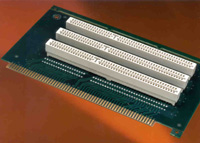 Photo ©1998 AMP INC.
Photo ©1998 AMP INC.In order to obtain enough contact force, a metal with sufficient yield strength must be selected. Each alloy has several strength levels (tempers) available. Higher tempers have higher yield strength and thus can provide higher contact forces. Formability is one reason that the highest temper isn't always the "best" temper for a spring contact. And even when formability is not a problem, care should be exercised in temper selection, because higher tempers can lead to acceleration of stress relaxation. This effect occurs in all tempers, indeed in all metals, and is consistent with the metallurgical mechanisms at the root cause of stress relaxation.
It should not be concluded that higher tempers must be avoided, unless the utmost in structural stability is required. To obtain sufficient initial contact force, a high temper selection is often necessary. For example, the yield strength of cartridge brass in the spring temper is 86 ksi whereas in the half hard temper it is only 51 ksi . Even with its greater stress relaxation, spring temper cartridge brass will have 55 ksi remaining after ten years, while half hard cartridge brass will only have 38 ksi left. The part made from spring temper can provide 45% more contact force after 10 years, even though its loss of stress was much greater! It had such an initial advantage that it retained its superiority. Clearly, spring temper can provide a higher contact force throughout a ten year design life, although half hard is the more stable of the two tempers.
"Percent stress remaining" must not be confused with "stress remaining"; the former is an indication of contact force stability (the actual contact force may be high or low). The latter is indicative of the actual contact force and determines whether it really is high or low. This point is also applicable to alloy selection. Some rather low strength alloys have excellent stress relaxation resistance, equal to or better than many higher strength alloys. But higher strength alloys frequently offer higher contact forces over the design life. As with higher tempers, higher strength alloys start off with a big advantage on the contact force afforded. And their relaxation resistance is often sufficient to retain that superiority.
The stamping and forming processes used to convert metals from flat strip to finished contacts will cause residual stresses which may affect the behavior of connectors, including stress relaxation. However, this effect has so far resisted quantitative evaluation and is probably only of secondary significance.
